Making a garden bed for your plants is not the end. The box may slide and fall off due to the weight of the soil or if the place is sloppy. So, how do you stop the box from sliding or falling off?
Anchoring the raised bed can keep the bed from sliding or falling over, so you must anchor the bed before filling it. It would be best to anchor well so that it remains attached from inside to the bed. Anchoring is not only required for beds over the slopes but for all the beds in every location.
The main thing about anchoring is to understand which materials can be used to anchor or reinforce the raised beds. This article will share the reasons behind anchoring, the materials required, and the steps to anchor or stake the garden bed.
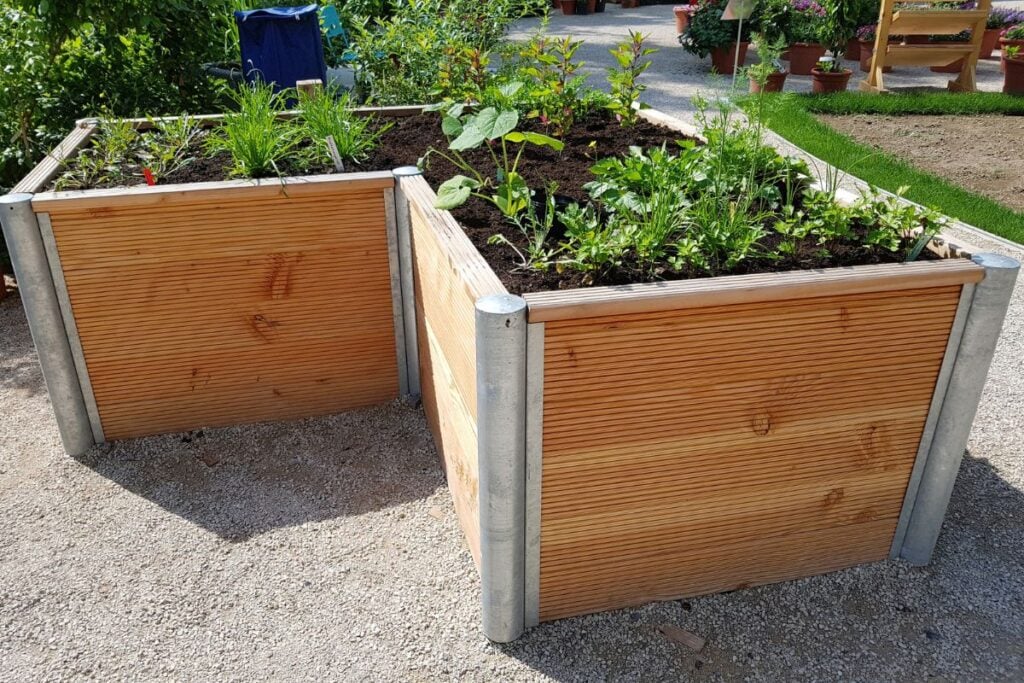
Should I anchor raised beds?
If you are a beginner at creating raised beds, you must make sure to give them extra support so that they can stand in their place without falling over.
Raised beds work somewhat like containers.
When you buy pots for plants, as a grower, you always ensure that the pot can handle the plant you grow.
The same is for the raised beds.
When you create beds, you should ensure they can carry the weight of the soil and the plant.
Sometimes, when you fill the raised bed with soil, the weight of the soil can make the raised bed bend sideways and fall over, especially when you water them.
As a result, the soil will get out of the bed.
Though it can happen anywhere, the condition is seen the most in slopy areas where the land is slightly inclined.
The more soil you add, the more pressure the bed will have to handle.
So, if the sides are not anchored properly, the bed will fall over.
If your raised bed is over a slope, anchoring is a must.
It will keep things in place without any learning.
Not all places have flat ground surfaces for steady beds.
So, if your area is sloppy, anchor the raised beds to prevent gravity and erosion from displacing the soil from its place.
It doesn’t matter if your bed is tall or short in height.
Anchoring will keep the plant and soil in a better condition for a long time.
Water takes away the debris downhill, and erosion can take away the soil and raised bed amends you have made down the hill.
So, anchor the hillsides with some walls and anchor those holding walls to prevent displacement during floods or rains.
What materials are required for anchoring?
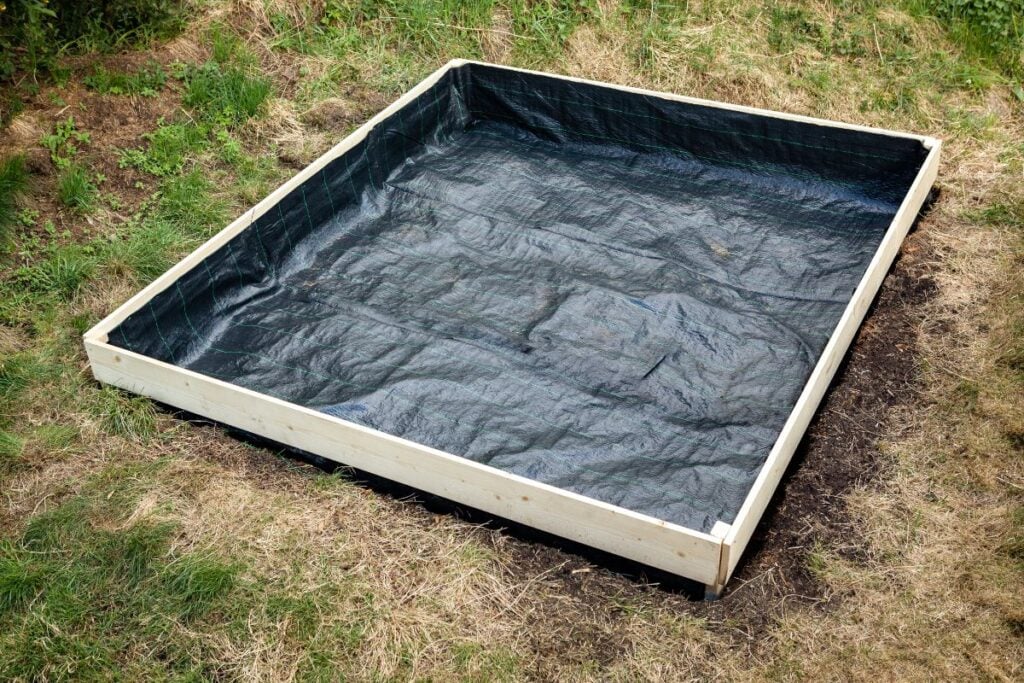
There are many things to use for anchoring like:
- Metal rebar
- Fencing stakes
- Wooden stakes
- Sideboards
Whatever products you use, ensure they are strong enough to hold the soil and the plant.
However, if you think the products you have used should be able to handle leaning over, you don’t have to anchor them initially.
You can do it later when needed.
Sometimes, your made bed will require anchoring at the time of creating the bed, do it.
If your raised bed is on an inclined ground or the soil erosion or sliding can trouble your bed, you should go for the anchoring at the time of making the bed to keep it in place.
Metal rebars are generally used in rocky soil.
It might be quite an effort, but it is worth it.
The support it gives at the end will be great.
Another option is the stakes.
You can use fencing and wooden stakes for multiple purposes.
The stakes may be costly, but they will give the corners and boards of your raised beds enough security.
You can create holes over the stakes by screwing them with the raised bed. Some are flat enough for brackets.
You can also use these stakes as string wire at the top to support your vining plants and prevent them from falling over.
If you have bird or pest problems, these stakes can help to keep them away. Put some stakes and create a fence around your bed.
How do you secure a raised bed to the ground?
Anchoring a raised bed means adding some stakes or other support materials like metal rebars, wooden or fencing stakes, or sideboards at the corners of your raised bed.
These materials will support your bed and help prevent it from falling over or slipping.
It would be best to anchor the raised beds while making the beds.
It will allow you to make the support system beforehand without disturbing the bed and the plants later.
However, you can also do it later if your raised bed material doesn’t need it for now.
A step-by-step guide to creating and anchoring raised beds
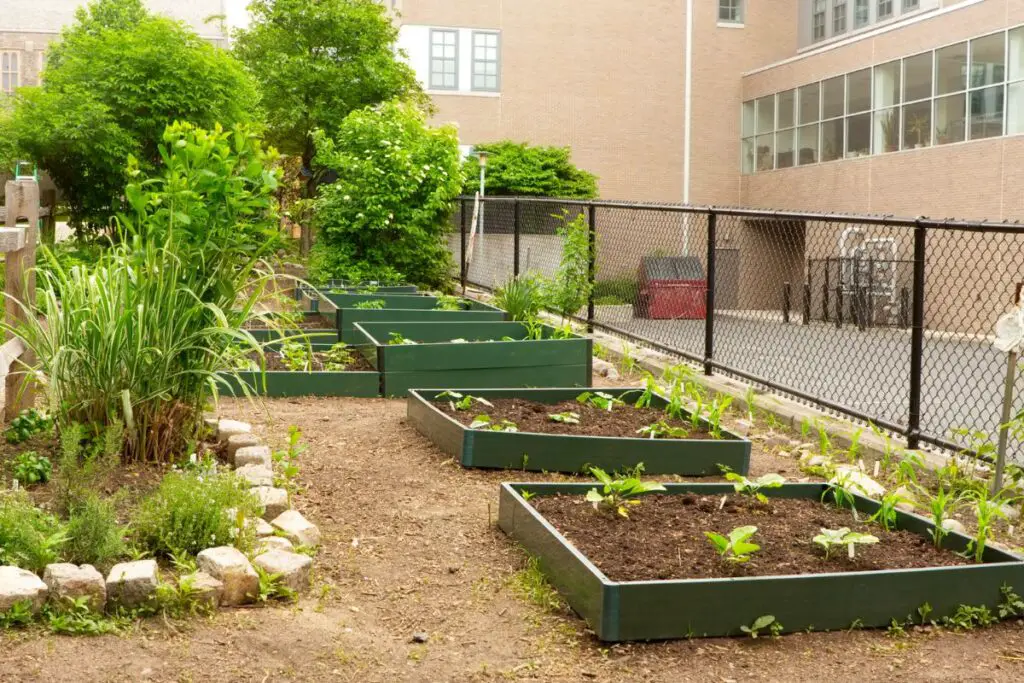
Here are the steps to create a bed and anchor it as well.
So, get into it right away:
Looking for gardening supplies? We have tested 100's of products before recommending them to you guys. Check out our best pick below:
| Image | Gardening Supplies | Best Price? |
|---|---|---|
 Top
Top Top
Top | Raised Garden Bed Kit | Check On Amazon |
 | XLUX Soil Moisture Meter, Plant Water Monitor, Soil Hygrometer Sensor for Gardening, Farming, Indoor and Outdoor Plants, No Batteries Required | No Results |
 Top
Top Top
Top | 82 Pcs Garden Tools Set and Extra Succulent Tools Set | Check On Amazon |
 | Joeys Garden Expandable Garden Hose with 8 Function Hose Nozzle, Lightweight Anti-Kink Flexible Garden Hoses, Extra Strength Fabric with Double Latex Core, (50 FT, Black) | No Results |
 Top
Top Top
Top | Dual Chamber Compost Tumbler | Check On Amazon |
 Top
Top Top
Top | Sunnyglade Plant Stakes | Check On Amazon |
 Top
Top Top
Top | Organic Cold Pressed Neem Seed Oil | Check On Amazon |
 Top
Top Top
Top | Mighty Mint Gallon :-Insect and Pest Control Peppermint Oil | Check On Amazon |
 Top
Top Top
Top | Scotts DiseaseEx Lawn Fungicide | Check On Amazon |
 Top
Top Top
Top | Jacks Classic 20-20-20 All Purpose Fertilizer | Check On Amazon |
 Top
Top Top
Top | 30,000 Seeds Pollinator Attracting Wildflower Mixture | Check On Amazon |
 Top
Top Top
Top | Survival Vegetable Seeds Garden Kit-Over 16,000 Seeds | Check On Amazon |
1. Measure the area
Begin with measuring the area of your garden and estimating the length, breadth, and height of the bed you want to make.
Also, check the location and find out whether the area is inclined.
If you have flat surfaces, consider taking that space.
Otherwise, you can grow over the slope areas.
2. Get the ingredients
Decide what material you want to use for making raised beds.
There are several things, like wood, lumber, raw wood, bricks, natural stones, masonry, metals, etc.
Woods are famous among these.
Usually, a raised bed should not be wider than 4 feet.
The height depends on the plant you grow and the place you create the bed.
3. Prepare the stakes
If you use stakes for anchoring, take 2 inches by 18 inches.
It will create enough space to put the stakes in the ground.
Make the end of the stakes pointy so that driving them to the soil inside the raised bed gets easier.
For sideboards, you can take 1-inch by 2 inches boards and collect them into 4 pieces twice the length of the raised bed.
Cut 2 inches at the bottom at an angle to create a pointy end so that you can stake it properly with the raised beds.
The sizes for metal rebars are more or less the same.
4. Put the stakes around the garden bed
Now, collect the stakes, boards, or whatever you have taken for anchoring and drive the long stake into the ground, at least an inch deep into every corner of your garden bed.
If your raised bed is long, like 12 feet, place one stake at the center of each side of the bed for extra reinforcement.
It will give the bed more support and prevent it from sliding over.
Also read: How Deep Should A Raised Garden Bed Be?
5. Secure the raised bed
Once you have placed the stakes into the ground, it is time to secure them with the beds at every corner.
Put the metals or stakes at every corner of the bed to give them support.
For stakes, you can drill holes through the stakes and the garden bed.
For securing, attach and screw the stakes with the bed using a 2-inch long screw.
For that, make two holes at two places, 3 inches apart.
You may also add the stakes or metals outside the bed at particular intervals to give the bed more support.
Your anchoring is complete.
Now, check that the bed doesn’t lean over due to the ground or the weight of the soil.
6. Provide extra support
You can also use larger stakes to double the security or to secure the sides directly to the stakes.
You can even use metal brackets at the corner of the raised bed.
These metals will give your bed support for a longer time.
You may add some stakes later as particular intervals to give your bed extra support.
7. Add soil
Now, fill up your garden bed with the required soil after the anchoring is over.
Use a soil mix ideal for the plants you have planned to grow.
While adding the soil, you can use amendments like compost to improve the soil quality.
Before adding the soil, add something at the bottom of the bed.
It will create a barrier between the ground and the bed soil.
Avoid using contaminated materials or soil.
Always use healthy and sterile soil to keep your plants healthy and increase their lifespan.
8. Plant your plants in the raised beds
Start planting your selected plants in the raised beds.
Square foot gardening practices are much better and more effective because they can maximize plant growth and prevent weeds.
How do you keep raised beds from bowing out?
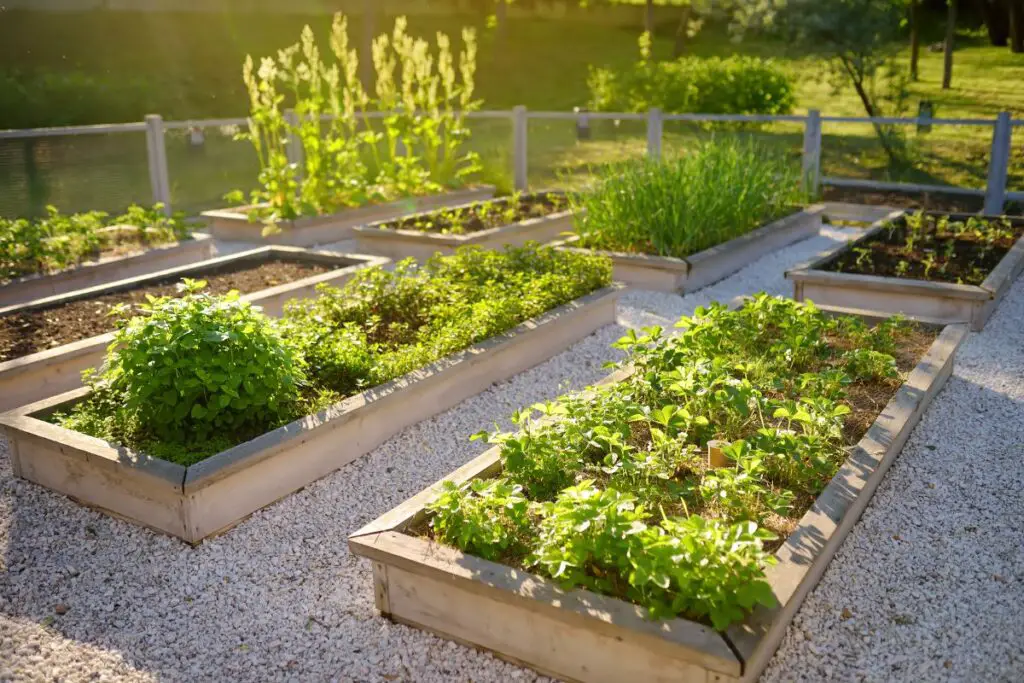
Controlling the bowing is another way of anchoring and reinforcing them.
To prevent this from the very beginning, you have to make the raised beds with sturdy products and use strong materials for anchoring.
Here are the steps to prevent bowing:
1. Stabilize the beds
Your first duty is to stabilize the raised beds to prevent bowing.
The sides of the beds have long structures, and support is needed in the middle of the sides.
Make sure that your raised beds are over solid flat surfaces, like concrete or patio or flat ground level.
It will help to anchor easier and prevent bending.
2. Make beds with strong materials.
Beds made with strong woods, lumber, masonry, bricks, or natural stones have lower chances of bowing over than those made with old woods and branches.
Don’t use any thin and cheap materials for making the beds.
These have higher chances of bowing, and you might not save the bed for long, even with proper anchoring.
Even if you anchor them, it will take a lot of effort.
The main cause of bowing is a sloped area or heavy soil.
Even if the soil doesn’t make the bed bow, the water will make the bed bow.
The corners of the raised bed should be 4x4s, and the sides should be 2 inches thick.
It will make sure that the beds don’t bow or bend sideways.
Using metal rebar can help greatly in anchoring than other products.
Metals are strong, and they can hold the bed for longer periods.
They will give proper stabilization.
Whether you use metal rebars, wood stakes, or sideboards, additional metal brackets will help support the bed for longer periods.
3. Maintain your beds properly
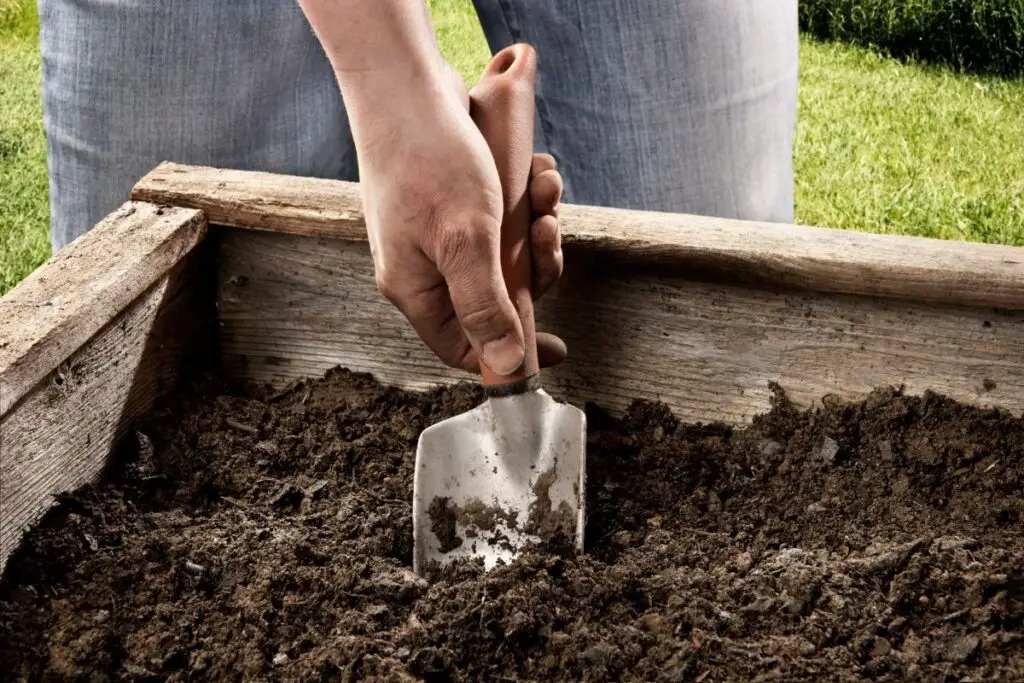
Bowing is the reason why the beds require anchoring.
So, it is fine if you don’t have any other option than anchoring.
But, if you can avoid anchoring by making the bed strong, it would be great and can save you time and effort.
However, at some point, your beds will require anchoring.
The main cause of bowing is heavy soil.
The less you water the soil, the less heavy the soil will be.
So, minimize the watering and water the plants only when they need it.
Use pressure-treated lumber so that the need for anchoring gets minimized.
However, you will need it later, but not while creating the beds.
Final thoughts
Anchoring keeps the raised bed and everything inside the bed in place. It prevents bending over and falling off. Since these conditions have higher chances in the slope areas, anchoring is much needed at such places.
However, you can still anchor your raised beds over flat surfaces. The bed may fall over or bow if the soil is very heavy, especially after watering, or your bed is made of wood and has become very old.
You can use wooden stakes, fencing stakes, metal rebars, and sideboards for anchoring. Though you can use all, mostly wooden stakes and metal rebars are used. They give much better support than other materials.
Put each one of the materials at each corner, both inside and outside. You may even add some later at intervals to give extra support.
Reference: ScienceDirect, American Society of Agronomy, Noble Research Institute, Building a Raised Bed Garden, Developing design guidelines for calculating of width and height of raised bed.
